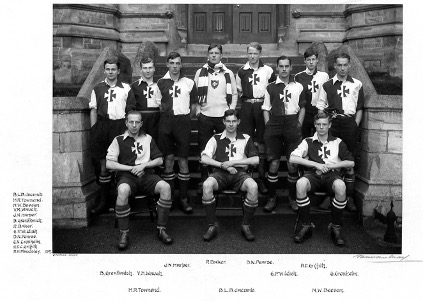John Neill Harper

| Rank: | Captain |
| Regiment: | Royal Armoured Corps, 2nd Royal Gloucestershire Hussars |
| Country: | Egypt |
| Service Number: | 68817 |
| Cemetary/Memorial: | El Alamein Memorial (Column 24) |
| Awards: | 1939-45 Medal Star 1939-45 |
Born in 1917, Captain Harper died 19th November 1941, aged 24, in Libya.
He was the eldest son of Kenneth John and Ruth Harper of Gloucestershire.
John was a pupil at St Ronan’s from 1925 to 1930 and was a keen sportsman, playing for both the football and rugby sides.
With reference to rugby, The Ronian reports: “Harper is head and shoulders above everyone else on the side at present, his judgement being splendid, and seldom can we have had anyone who worked so hard”.
“Harper, too, has had a splendid record; Third Prefect, three years in the rugger side and Vice-Captain, and in the opinion of some here, the best rugger player we have ever had; two years in the soccer side (and a really good centre-half) and a definite leader in the School life.”
He went on to attend Malvern from 1931 to 1936 where he was in House 4. He was a College Prefect, one of 12 out of a school of 500 pupils and a sixth form of almost 80. He played football for the First X1, won athletics Colours and obtained a Ledbury Cap, ie he came in the top nine in the College's annual eight mile run. He was a Lance Sergeant in the Officer Training Corps.

Malvern, 1935
Just before the war the RGH was divided into two and 2RGH became part of 22nd Armoured Brigade (with the 3rd and 4th County of London Yeomanry). It was equipped with the Mk. VI Cruiser, or Crusader, tank. Leaving England in the winter of 1941, on HMT Strathmore, the 2nd RGH landed at Port Suez on 1st October.
The Regiment strength was 43 officers, 585 men, 52 tanks, 10 scout cars, and 112 other vehicles.
At 6am on 18th November 1941, the 2RGH advanced into enemy territory, in Libya, for the first time. Near Bir El Gubi the Regiment saw its first action, but outnumbered six to one was forced to withdraw. During the action Captain Harper was killed.
His Company Commander wrote as follows:
"The squadron had to stand up to some 150 enemy tanks and we had to take some heavy punishment. John as usual was right up at the front and giving everything he had got until he was killed instantaneously by a small arms bullet. He was far and away my best Troop Leader and his wonderful keenness and complete fearlessness was a grand example and inspiration to us all."
His Housemaster at Malvern added, "those of us who knew John at School would have expected nothing less".
